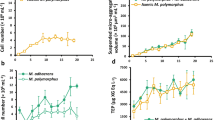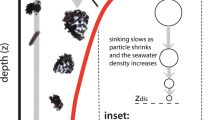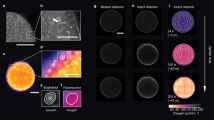Abstract
The formation and sinking of biogenic particles mediate vertical mass fluxes and drive elemental cycling in the ocean1. Whereas marine sciences have focused primarily on particle production by phytoplankton growth, particle formation by the assembly of organic macromolecules has almost been neglected2,3. Here we show, by means of a combined experimental and modelling study, that the formation of polysaccharide particles is an important pathway to convert dissolved into particulate organic carbon during phytoplankton blooms, and can be described in terms of aggregation kinetics. Our findings suggest that aggregation processes in the ocean cascade from the molecular scale up to the size of fast-settling particles, and give new insights into the cycling and export of biogeochemical key elements such as carbon, iron and thorium.
This is a preview of subscription content, access via your institution
Access options
Subscribe to this journal
Receive 51 print issues and online access
$199.00 per year
only $3.90 per issue
Buy this article
- Purchase on Springer Link
- Instant access to full article PDF
Prices may be subject to local taxes which are calculated during checkout


Similar content being viewed by others
References
Mc Cave, I. N. Vertical flux of particles in the ocean. Deep-Sea Res. 22, 491–502 (1975)
Chin, W., Orellana, M. V. & Verdugo, P. Spontaneous assembly of marine dissolved organic matter into polymer gels. Nature 391, 568–572 (1998)
Wells, M. L. A neglected dimension. Nature 391, 530–531 (1998)
Volk, T. & Hoffert, M. I. in The Carbon Cycle and Atmospheric CO2; Natural Variations Archaen to Present (eds Sundquist, E. T. & Broecker, W. S.) 99–110 (Geophys. Monogr. 32, American Geophysical Union, Washington DC, 1985)
Dugdale, R. C. & Goering, J. J. Uptake of new and regenerated forms of nitrogen in primary productivity. Limnol. Oceanogr. 12, 196–206 (1967)
Eppley, R. W. & Peterson, B. J. Particulate organic matter flux and planktonic new production in the deep ocean. Nature 282, 677–680 (1979)
Passow, U. Transparent exopolymer particles (TEP) in the marine environment. Prog. Oceanogr. 55, 287–333 (2002)
Engel, A. The role of transparent exopolymer particles (TEP) in the increase in apparent particles stickiness (α) during the decline of a diatom bloom. J. Plankton Res. 22, 485–497 (2000)
Asper, V. L., Deuser, W. G., Knauer, G. A. & Lorenz, S. E. Rapid coupling of sinking particle fluxes between surface and deep ocean waters. Nature 357, 670–672 (1992)
Nanninga, H. J., Ringenaldus, P. & Westbroek, P. Immunological quantification of a polysaccharide formed by Emiliania huxleyi. J. Mar. Syst. 9, 67–74 (1996)
Engel, A. et al. TEP and DOC production by Emiliania huxleyi exposed to different CO2 concentrations: A mesocosm experiment. Aquat. Microb. Ecol. 34, 93–104 (2004)
Von Smochulowski, M. Versuch einer mathematischen Theorie der Koagulationskinetic von Kolloidteilchen. Z. Phys. Chem. 92, 129–168 (1917)
Ziff, R. M. & Stell, G. Kinetics of polymer gelation. J. Chem. Phys. 73, 3492–3499 (1980)
Ruiz, J., Prieto, L. & Ortegon, F. Diatom aggregate formation and fluxes, a modeling analysis under different size-resolution schemes and with empirically determined aggregation kernels. Deep-Sea Res. I 49, 495–515 (2002)
Geider, R. J., MacIntyre, H. L., Graziano, L. M. & McKay, R. M. L. Responses of the photosynthetic apparatus of Dunaliella tertiolecta (Chlorophyceae) to nitrogen and phosphorus limitation. Eur. J. Phycol. 33, 5315–5332 (1998)
Carlson, C. A. in Biogeochemistry of Marine Dissolved Organic Matter (eds Hansell, D. A. & Carlson, C.) 59–90 (Academic, Amsterdam, 2002)
Nielsen, M. V. Growth, dark respiration and photosynthetic parameters of the coccolithophorid Emiliania huxleyi (Prymnesiophyceae) acclimated to different day length–irradiance combinations. J. Phycol. 33, 818–822 (1997)
Amon, R. M. W. & Benner, R. Rapid cycling of high-molecular-weight dissolved organic matter in the ocean. Nature 369, 549–552 (1994)
Benner, R. in Biogeochemistry of Marine Dissolved Organic Matter (eds Hansell, D. A. & Carlson, C.) 59–90 (Academic, Amsterdam, 2002)
Del Giorgio, P. A. & Duarte, C. M. Respiration in the open ocean. Nature 420, 379–384 (2002)
Pakulski, J. D. & Benner, R. Abundance and distribution of carbohydrates in the ocean. Limnol. Oceanogr. 39, 930–940 (1994)
Biddanda, B. & Benner, R. Carbon, nitrogen, and carbohydrate fluxes during the production of particulate and dissolved organic matter by marine phytoplankton. Limnol. Oceanogr. 42, 506–518 (1997)
Baines, S. B. & Pace, M. L. The production of dissolved organic matter by phytoplankton and its importance to bacteria, patterns across marine and freshwater systems. Limnol. Oceanogr. 36, 1078–1090 (1991)
Myklestad, S. M., Skånoy, E. & Hestmann, S. A sensitive and rapid method for analysis of dissolved mono- and polysaccharides in seawater. Mar. Chem. 56, 279–286 (1997)
Wu, J., Boyle, E., Sunda, W. & Wen, L.-S. Soluble and colloidal iron in the oligotrophic North Atlantic and North Pacific. Science 293, 847–849 (2001)
Passow, U. & Alldredge, A. L. A dye-binding assay for the spectrophotometric measurement of transparent exopolymer particles (TEP) in the ocean. Limnol. Oceanogr. 40, 1326–1335 (1995)
Porter, K. G. & Feig, T. S. The use of DAPI for identifying and counting aquatic microflora. Limnol. Oceanogr. 25, 943–948 (1980)
Wells, M. L. & Goldberg, E. D. Marine submicron particles. Mar. Chem. 40, 5–18 (1992)
Mari, X. Carbon content and C:N ratio of transparent exopolymer particles (TEP) produced by bubbling of exudates of diatoms. Mar. Ecol. Prog. Ser. 33, 59–71 (1999)
Mc Cave, I. N. Size spectra and aggregation of suspended particles in the deep ocean. Deep-Sea Res. 31, 329–352 (1984)
Acknowledgements
We thank A. Terbrüggen for technical assistance and M. Schartau for discussions. This work was supported by the Large-Scale Facility of the University of Bergen, Norway and the European Commission Human Potential Programme.
Author information
Authors and Affiliations
Corresponding authors
Ethics declarations
Competing interests
The authors declare that they have no competing financial interests.
Rights and permissions
About this article
Cite this article
Engel, A., Thoms, S., Riebesell, U. et al. Polysaccharide aggregation as a potential sink of marine dissolved organic carbon. Nature 428, 929–932 (2004). https://doi.org/10.1038/nature02453
Received:
Accepted:
Issue Date:
DOI: https://doi.org/10.1038/nature02453
This article is cited by
-
Three marine species of the genus Fulvivirga, rich sources of carbohydrate-active enzymes degrading alginate, chitin, laminarin, starch, and xylan
Scientific Reports (2023)
-
The impacts of ambiguity in preparation of 80% sulfuric acid solution and shaking time control of calibration solution on the determination of transparent exopolymer particles
Acta Oceanologica Sinica (2023)
-
Pulsed export of carbon in the north-western Mediterranean Sea
Journal of Oceanology and Limnology (2023)
-
Verrucomicrobiota are specialist consumers of sulfated methyl pentoses during diatom blooms
The ISME Journal (2022)
-
Enigmatic persistence of dissolved organic matter in the ocean
Nature Reviews Earth & Environment (2021)
Comments
By submitting a comment you agree to abide by our Terms and Community Guidelines. If you find something abusive or that does not comply with our terms or guidelines please flag it as inappropriate.



